There are many types of pedals on the market, and choosing the right one for you is important. This bike pedal guide will outline the main types of pedals, good examples of them, and who they will suit.
Overview
At a very high level, there are clip-in and flat pedals.
There are two main types of clip-in pedals the two-bolt cleat system typically used for mountain biking and the three-bolt cleat system typically used for road cycling. The two-bolt system is embedded in the sole and is better for walking, while the three-bolt system provides a more secure connection to the shoe and pedal.
Flat pedals are mostly used for dirt jumping, BMX, and mountain biking. However, they are also commonly used for commuting and general riding. Mostly the material and grip level separates flat pedals apart.
Check out the sections below for deep dives into each type of pedal.
Types of Clipless Mountain Bike Pedals
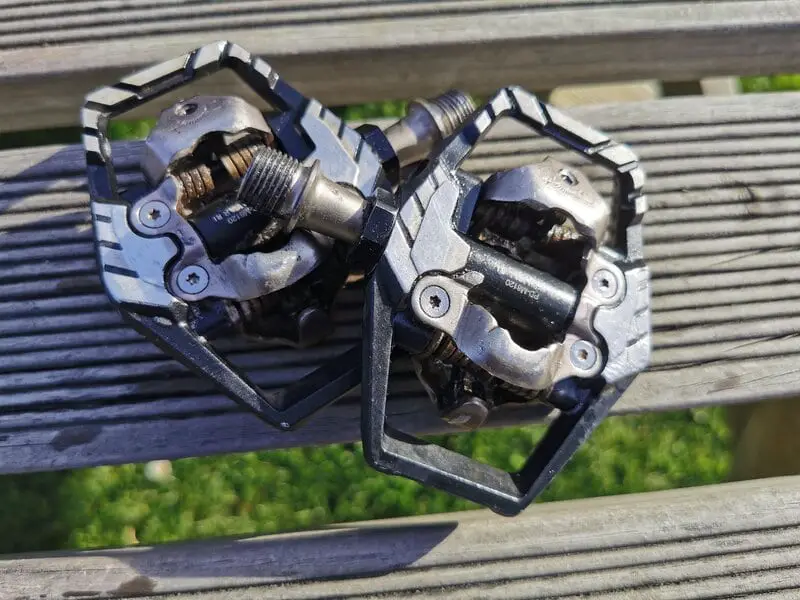
Clipless mountain bike pedals are pedals specifically designed for mountain biking. Sometimes referred to as clip-in pedals, they are pedals where you are attached to pedal. They are designed to be durable, have adjustable unclipping difficulty, and have good mud shedding abilities. They have greater power transfer from foot to pedal than flat pedals but not as good as road bike shoes.
For more on flat vs clipless pedals, check out our in-depth discussion of who suits which.
They require specific clipless mountain bike shoes and come in a variety of styles ranging from no platform for cross country riding all the way to large platform pedals for downhill mountain biking. Check out our review on the best mountain bike shoes on the market.
All clipless mountain bike pedals are designed for the two-bolt cleat design. This means that you will need to also purchase mountain bike specific shoes that feature the two-bolt cleat mechanism within the sole of the shoe as shown below. Note that shoes don’t come with the cleats as they usually come with the pedals. Cleats are easy to install on a MTB shoe and you can check out our guide on how to install cleats when the time comes.
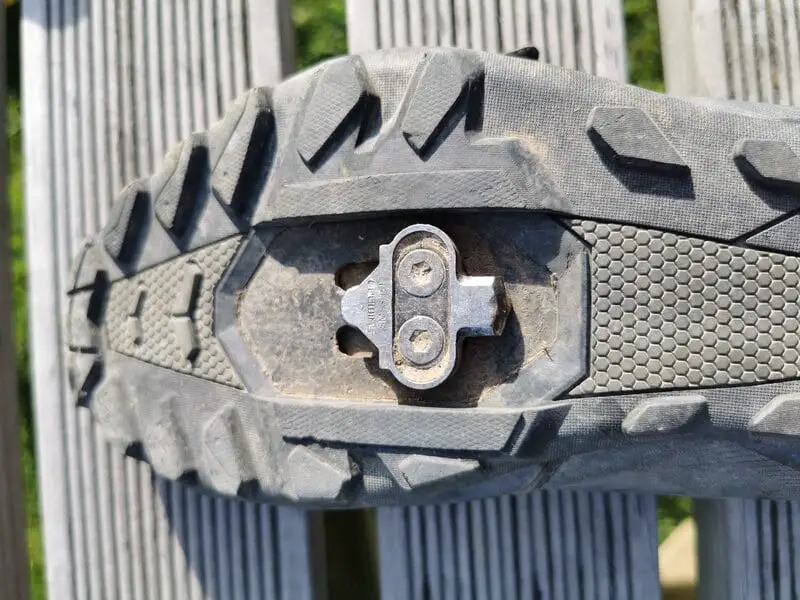
Who They Are Made For
They are made for mountain bikers who want to gain the maximum pedaling efficiency on the bike, and those who like the security of being attached to the bike when the going gets rough!
It’s worth noting that when going into rough terrain, clipless shoes require a lot more commitment from the rider as it is not that easy to dab the foot when things get rowdy. Check out the best clipless pedals for beginners to make that transition from flats to clips much easier.
Although designed for mountain biking, they can be used for road biking; however, the pedals and shoes are much heavier than their road counterparts and will not provide the same level of power transfer that road bike shoes and pedals offer.
Clipless mountain bike pedals are also an excellent option for commuters. They are easy to use, and clipless MTB shoes are relatively comfortable to walk in.
Cross Country Pedals
Cross country mountain bike pedals are, funnily enough, designed for cross country racing. This means that weight and power transfer are top priorities in the design. This is shown by the lack of a platform and very minimalistic design.
The two most common cross-country mountain bike pedal styles are the Shimano PD-M520 and the CrankBrothers Eggbeaters shown below.
Due to cross country pedals lightweight design and better power transfer, they also make good commuter pedals. If you commute on a bike and want to use clipless pedals, then this style will be best suited for you.
Enduro Pedals
Enduro pedals have the same clip in mechanism as cross country pedals, but they have a cage and platform. The cage around the clip mechanisms protects the pedal from getting damaged if it hits a rock or something similar.
The platform provides extra area for your foot to sit on the pedal, boosting confidence and providing a better feel on the bike when descending. The platform also offers more support for your foot if you don’t manage to clip back in straight away.
Two common enduro pedals are the Shimano Deore XT PD-M8120 Pedal and the Crankbrothers Mallet E pedals. There is a whole range of enduro pedals out there, but these are two of the most common and show the typical enduro pedal design.
Check out our comparison of the Shimano XT vs XTR.
Downhill Pedals
Downhill pedals are similar to Enduro pedals, with the key difference being the platform’s size on the pedal. A larger platform on the pedal gives a larger area for the foot to make contact with the pedal. A larger platform is more confidence-inspiring for rough technical terrain and also allows you to control the bike more with your feet. It also means that if you end up unclipped, you can ride it out with no issues.
Two common downhill pedals are the Shimano Saint SPD M820 and the Funn Mamba clipless pedals. Both these pedals are SPD compatible and have a larger platform for extra support riding rough terrain.
Types of Flat Mountain Bike Pedals

Flat mountain bike pedals are pedals where you are not attached to the bike, and your foot just sits on top of the pedal. Flat pedals come in a variety of different materials, sizes, and grip mechanisms.
Most flat mountain bike pedals are machined from an aluminum alloy with an increasing amount being made of a composite material. Some high-end flat pedals are made from materials like titanium and magnesium for weight-saving purposes.
Most flat pedals will use pins for extra grip on the pedal to reduce the amount that your feet bounce around on the pedals. Typically, these pins are replaceable, and the more expensive flat pedals will have adjustable pins so that you can customize the pins and get a grip level that is right for you.
Flat pedals are best paired with skate styled shoes with a soft rubber sole. Check out our top flat pedal mountain bike shoes. The soft rubber sole allows the pins to sink into the shoe, making your feet more secure, which is great when the trail gets rough!
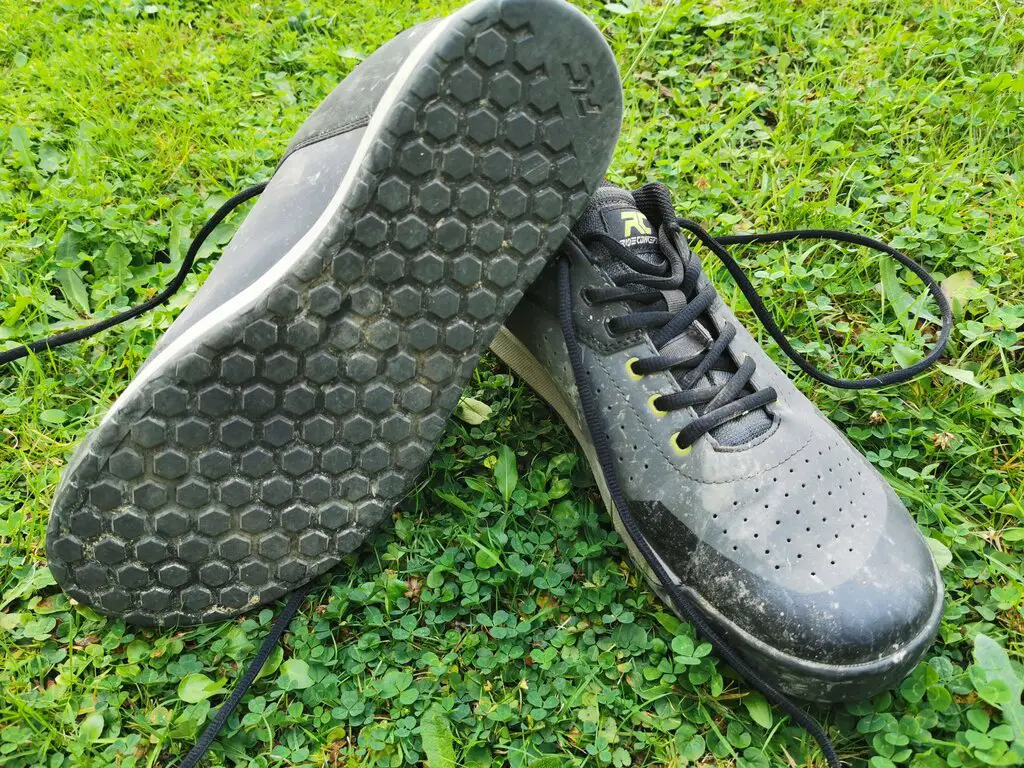
Check out our flat pedal mountain bike guide for more.
Who They Are Made For
Flat pedals are great for beginners as you are not attached to the bike and so it is super easy to take your foot off in an emergency. This is great for when you are starting and can boost your confidence on the trails knowing that if you need to unclip, you can.
Flat pedals are also great for riders who like to have the freedom of quickly removing their feet from the pedals. This is down to personal preference on how you like to ride. Once you have been riding for a bit, you will know what you like to ride. Personally, I ride clipless pedals as I like being secure on the bike when the going gets rough.
Flat pedals are also great for jumping, and it ensures you are jumping with the correct technique. You can also be much more playful on the jumps with flat pedals, which appeals to a lot of people who like to jump on bikes.
Flat Pedal Examples
The two main types of flat pedals are aluminum (alloy) and composite. A great example of an alloy pedal is the Crankbrothers Stamp 7 pedal shown below.
Composite pedals are typically much cheaper than their alloy counterparts and can offer a great value pedal on a budget. One of the best composite pedals on the market is the OneUp Components Composite Pedal shown below.
Types of Road Bike Pedals
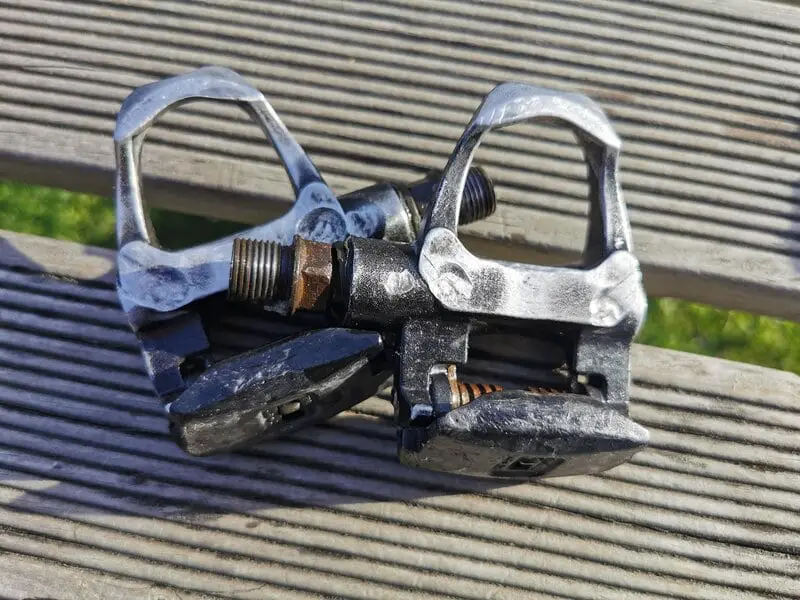
Road bike pedals are aimed at those who exclusively ride on sealed roads for long distances. They priorities power transfer and stability for putting large amounts of power through the pedals.
They are very different from the MTB 2-bolt cleat system as the cleats are attached to the shoe using a 3-bolt system. The cleats are also much larger, which makes transferring large amounts of power to the pedals much more comfortable.
Due to the size of road bike cleats walking in road bike shoes is very awkward and does make you look a bit silly. The system is great on the bike but not so good for walking off the bike. Road bike shoes are also very stiff which again doesn’t help with walking in them.
Check out an in-depth discussion on the difference between road and mountain bike pedals.

Who They are Made For
Road bike pedals are only designed for those that do a lot of kilometers on the road or for those racing road bikes. They are purely designed for power transfer and not much else. Therefore, they only suit those who are looking to get the most out of every pedal stroke.
Road Pedal Examples
There are two main types of road bike pedals. The first and most common is the one-sided clip-in pedal with the three-bolt cleat system. This is used by most manufacturers, including Shimano and some Look pedals. A great example of this kind of pedal is the Shimano Ultegra R8000 SPD pedal shown below.
One of the more popular pedals on the market it is the go-to for many road riders as a lightweight durable road bike pedal. Offers everything you need in a road bike pedal and for a reasonable price.
The other type of pedal is the Speedplay Zero Chromoly pedal. This offers dual-sided entry and a lightweight design, which is popular with many riders. Single-side entry pedals are ok when not clipping in and out regularly, like on long rides in the countryside. However, they are not great around town as clipping in and out takes a little bit of getting used to. This is where the Speedplay is a great option offering the best of both worlds.
The alternative to the standard road bike pedal and offers dual-sided entry. These are a user-friendly, lightweight road bike pedal.
Types of Commuter Pedals
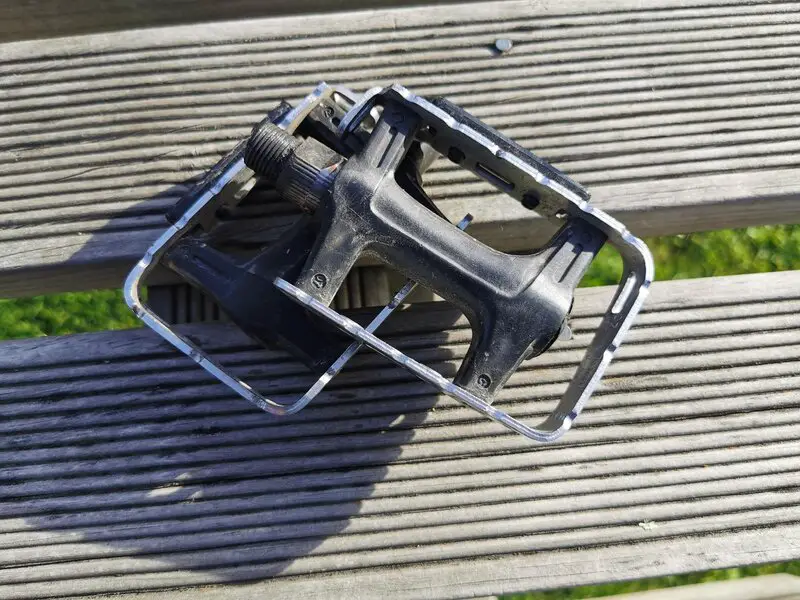
Commuter pedals are a slightly different category as you can use any of the pedals listed before to commute in. However, each has their advantages and disadvantages. There are a few types of pedals that target commuters. These are the dual-purpose pedals, flat pedals, and the old school toe clip pedals.
Commuter pedals are designed for those cycling to and from work or even just as a mode of transport around the city. Some pedals are dual-purpose and can be used for commuting and mountain biking. If you have a long commute, then using clipless mountain bike pedals and shoes is a great way to make things a little easier for yourself.
If you just have a short commute, then flat pedals are probably best for you as you don’t need to take a separate pair of shoes into work. Mountain bike specific flat pedals are not good for commuting as the pins used for grip tend to destroy regular shoes.
Commuter Pedals Examples
The first type is for those who want to use clipless shoes and pedals for commuting. For this, you would be best suited to a pair of mountain bike shoes and pedals as these are more friendly to use around town and are a lot more comfortable to walk in than road bike shoes. A great option is the Shimano’s cross country mountain bike pedals, the Shimano PD-M520 pedal set.
Those who want to commute in normal shoes but want to ride clipless mountain bike pedals for recreational riding, the dual-platform pedals are perfect for you. They feature one side with a clip mechanism, and the other is a flat pedal. The downside to this is only one side can be clipped into which takes a bit of getting used to out on the trail. A great example of this is the Shimano PD-EH500 SPD pedals shown below.
If you are looking for a durable, stable, and reasonably priced dual platform pedal, then this is the go-to. It has a relatively small platform that keeps out the way of obstacles while riding but still serves its purpose when riding in flats around town.
The next option is the flat pedal with a toe box that secures your foot in place. These are really old school, and it is what was used before clipless pedals. In my opinion, these are not a good option as they can be very dangerous. In my experience, I find that it can be very hard to get your feet out of the cage, especially in emergency situations. Therefore, we keep away from those types of pedals.
Another unusual option for commuters is folding and removable bike pedals, these are a bit different so we created a whole article about folding pedals here and removable pedals here.
The final option for commuters is a nice cheap pair of flat pedals that don’t have huge pins ready to destroy your shoes. These are a great option for short commutes, and they can be used with any kind of shoe. A good example of this kind of pedal is the BV bike pedal.
These pedals are only suited for commuting and general riding around town. They have everything you need and nothing you don't, a great cheap option for a commuter.
Conclusion
Ultimately the type of pedal that is right for you depends on the type of riding you do. There are many pedal types on the market, and finding the one that suits your riding style ultimately comes down to personal preference. This guide outlines the types of pedals, pick which one will suit your riding, and then decide whether you could actually ride in it without any issues popping up.
For more on the different type of pedal threads, check out our guide to pedal threads.




